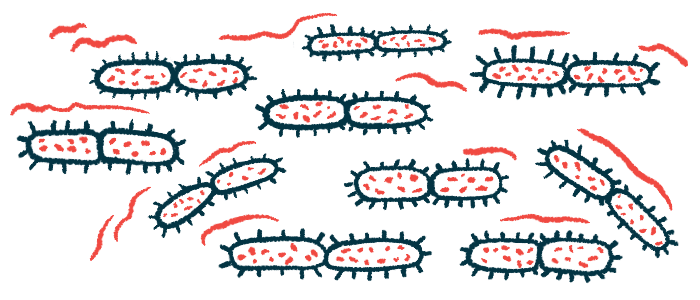Grant supports study of antibiotics with liquid crystalline nanoparticles
Developments in Australia could lead to better treatment of lung infections
Written by |

A grant of $500,000 in Australian dollars (around $326,000) will support researchers there in the development of antibiotics formulated with liquid crystalline nanoparticles (LCNPs), the better to eliminate hard-to-treat lung infections in people with cystic fibrosis (CF).
“By overcoming the processes that cause drug resistance and uncontrollable infection, this unique delivery approach can better target sites in the body where conventional antibiotic therapies cannot penetrate,” said Clive Prestidge, PhD, study lead and professor at the University of South Australia, in a university press release.
The funding to the University of South Australia scientists comes from Brandon BioCatalyst’s Cureator incubator through their Minimising Antimicrobial Resistance Stream, funded by the government’s Commonwealth Scientific and Industrial Research Organisation.
In their collaborative project, the researchers will employ a patent-protected technology, invented by the university’s Centre for Pharmaceutical Innovation, to develop therapies for people living with CF.
The buildup of thick, sticky mucus in the lungs that characterizes CF is a breeding ground for bacteria. As a result, CF patients commonly experience recurrent lung infections that can lead to damaging inflammation.
Treatments for such infections usually involve antibiotics, but recurrent infections and regular antibiotic use can result in bacteria becoming resistant to them. Moreover, mucus buildup in the lungs can make it difficult for antibiotics to reach bacteria, particularly those that can infect inside cells.
“That’s where liquid crystal nanoparticles can help,” Prestidge added.
A study of LCNPs
LCNPs are emerging as a method to promote cells’ acceptance of therapeutics because of their ability to fuse with cell membranes. They are formed by the self-assembly of double layers of lipids (fatlike molecules) and form interconnected water channels with the potential to carry antibiotics into cells.
In a previous cell-based study, LCNPs safely enhanced the antibacterial activity of antibiotics against Pseudomonas aeruginosa and Staphylococcus aureus, two types of bacteria that commonly infect the lungs of CF patients.
Prestidge’s team evaluated whether LCNPs can improve the antibacterial activity of two antibiotics: tobramycin and vancomycin.
LCNPs were created with and without dimethyldioctadecylammonium bromide (DDAB), a positively charged lipid that can interact with negatively charged cell membranes. Under a high-powered microscope, LCNPs formed a structure akin to a honeycomb, while LCNP-DDAB displayed an onionlike organization with larger internal pores.
In early toxicity tests, cells retained a viability above 80% across a range of LCNP and LCNP-DDAB concentrations. “Thus, the formulations were considered non-toxic for subsequent cellular studies,” the researchers wrote.
Using mouse macrophages, a type of immune cell, LCNPs increased the cellular uptake by four times relative to untreated cells, representing a 15% internalization. LCNP-DDAB further increased cellular uptake by more than 50%, which was three times greater than LCNPs.
In epithelial cells that line the airways, few neutral LCNPs were internalized, with less than 1% uptake. But positively charged LCNP-DDABs achieved a greater than 80% uptake in these cells.
The team then tested the LCNPs against two bacteria commonly found in CF lungs: Pseudomonas aeruginosa (P. aeruginosa) and Staphylococcus aureus (S. aureus).
While LCNP-DDAB demonstrated improved killing of P. aeruginosa in macrophages at a moderate dose of tobramycin, increasing doses of free tobramycin, as well as tobramycin encapsulated in neutral LCNPs, showed no effect.
In S. aureus-infected macrophages, treatment with vancomycin alone at all concentrations and vancomycin LCNPs did not reduce the bacterial burden. Consistently, treatment with LCNP-DDAB showed a significant reduction in bacterial viability at a moderate and high dose, resulting in over 55% bacterial killing.
In epithelial cells, tobramycin, with or without LCNPs, had no effect against both bacteria. In contrast, tobramycin encapsulated in LCNP-DDAB and at a moderate dose significantly reduced the P. aeruginosa bacteria. No reduction in bacteria count was observed across all treatments against S. aureus in epithelial cells.
“Further studies to evaluate [antibiotic] activity following longer treatment times and repeated dosing are also necessary to achieve the desired outcome,” the investigators wrote.
Scientists now aim to improve the technologies in a nebulized formulation, according to team member and postdoctoral researcher Santhni Subramaniam, PhD.
“Whether it’s bacteria in urinary tract infections, bone infections or bacterial biofilms found in tissue wounds, sinuses, and lung infections, preclinical trials of liquid crystal nanoparticles have delivered very positive results,” she said. “We are now positioned to advance a nebulization approach for direct lung delivery.”
“This is an exciting new technology that we hope will deliver significant improvement in people struggling with cystic fibrosis and other lung infections,” Subramaniam added.







